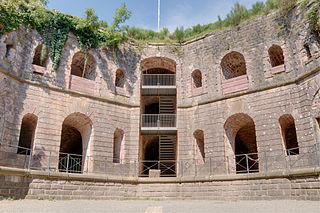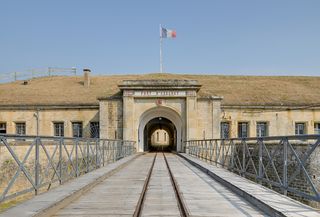
Ivry-sur-Seine is a commune in the Val-de-Marne department in the southeastern suburbs of Paris, France. It is located 5.3 km from the centre of Paris.

The Séré de Rivières system was an ensemble of fortifications built from 1874 along the frontiers, ridges and coasts of France. The fortifications were named after their architect, Brigadier-General Raymond Adolphe Séré de Rivières. The fortresses were obsolescent by 1914 but were used during the First World War.

Lieutenant Roger Hercule Gustave Degueldre was a French officer who was the leader of the OAS Delta Commandos in the last months of French rule in Algeria. The Commandos were responsible for attempting to ethnically cleanse the Pied-Noir neighborhoods of Algerians, as well as assassinating those considered "soft" or traitors to the cause of French Algeria.

The fortifications of Paris in the 19th and 20th centuries comprise:

Fort de l'Est is a military strong point designed to protect Paris. It was built between 1841 and 1843 in Saint-Denis at the direction of French prime minister Adolphe Thiers, and was part of an immense defensive belt comprising 17 detached forts and the Thiers Wall surrounding Paris. The evolution of artillery quickly made these fortifications obsolete.

The Batterie de Bouviers is located in the commune of Guyancourt, Yvelines, France. It is a former fortification built beginning in 1879 and occupied by the army until 1932. From 1933 it was leased by the Hispano Suiza company as a factory, surrounded by other industrial structures. The site was abandoned by Hispano Suiza in 1990, and was sold by the Ministry of Defense in 1999. In 2006 the battery became the "Cafe Musiques", surrounded by office buildings and a music school.

Fort de Champigny was built following the Franco-Prussian War to defend Paris. Located to the southeast of Paris in Chennevières-sur-Marne, the fort was part of an outer ring of fortifications built in response to improvements in the range and effectiveness of artillery since the construction of the Thiers fortifications of the 1840s. It was built in accordance with improved principles of fortification developed for the Séré de Rivières system.

Fort de Giromagny, also known as Fort Dorsner, was built near Belfort in northeastern France between 1875 and 1879. The fort forms the southern end of the defensive curtain of the Haute Moselle Region, abutting the fortified region of Belfort, which lies to its south. The Haute Moselle defenses form a link between the fortified encampments of Épinal and Belfort. The fort overlooks the main roads to the northeast of Belfort, which form a crossroads at Giromagny.

The Fort de Vaujours, located in the commune of Courtry, Seine-Saint-Denis, near the town of Vaujours, is one of the forts built at the end of the 19th century to defend Paris. It became a research center for the Commissariat à l'énergie atomique (CEA), France's Atomic Energy Commission. The center was closed in 1997.

Fort du Mont Bart is located to the south of Montbéliard, France. It was built between November 1874 and July 1877 as part of the Séré de Rivières system of fortifications. The fort overlooks the valleys of the Doubs and the Allan at an elevation of 497 metres (1,631 ft), standing to the south and rear of the fortified region of Belfort and in control of the road to Besançon. The fort was intended to augment the Belfort fortifications and to prevent an enemy from bypassing them. The most striking feature of the Fort du Mont Bart is its "interior street", originally constructed in the open air as a sunken court, then covered before World War I with reinforced concrete.

The Fort de Guentrange dominates Thionville in the Moselle department of France. It was built by Germany next to the town of the same name in the late 19th century after the annexation of the Moselle following the Franco-Prussian War. The Fort de Guentrange was part of the Moselstellung, a group of eleven fortresses surrounding Thionville and Metz to guard against the possibility of a French attack aimed at regaining Alsace and Lorraine, with construction taking place between 1899 and 1906. The fortification system incorporated new principles of defensive construction to deal with advances in artillery. Later forts, such as Guentrange, embodied innovative design concepts such as dispersal and concealment. The later forts were designed to support offensive operations, as an anchor for a pivoting move by German forces into France.
Fort Jeanne d'Arc, also called Fortified Group Jeanne d'Arc, is a fortification located to the west of Metz in the Moselle department of France. It was built by Germany to the west of the town of Rozérieulles in the early 20th century as part of the third and final group of Metz fortifications. The fortification program was started after the German victory of the Franco-Prussian War, which resulted in the annexation of the provinces of Alsace and Lorraine from France to Germany. The Fort Jeanne d'Arc was part of the Moselstellung, a group of eleven fortresses surrounding Thionville and Metz to guard against the possibility of a French attack aimed at regaining Alsace and Lorraine, with construction taking place between 1899 and 1908. The fortification system incorporated new principles of defensive construction to deal with advances in artillery. Later forts, such as Jeanne d'Arc, embodied innovative design concepts such as dispersal and concealment. These later forts were designed to support offensive operations, as an anchor for a pivoting move by German forces into France.

Raymond Adolphe Séré de Rivières was a French military engineer and general whose ideas revolutionized the design of fortifications in France. He gave his name to the Séré de Rivières system of fortifications constructed after the Franco-Prussian War of 1870. Described as the Vauban of the 19th century, his Belgian counterpart was Henri Alexis Brialmont.

The Fort d'Uxegney, or Fort Roussel, is part of the fortifications of Épinal. It was built near the village of Uxegney between 1882 and 1884, and was modernized in 1910. It is an example of a Séré de Rivières system fortification. It retains its armament and is maintained as a museum.

The Fort de Leveau, also known as Fort Schouller, is located in the commune of Feignies, France. It is part of the fortifications of Maubeuge, located to the northwest of the city, overlooking the railroad to Mons. The Séré de Rivières system fort was built 1882–1884, one of six forts built at the time. It is maintained as a museum by the town of Feignies.

The Fort de Bourlémont, or Fort Choiseul, was built between 1878 and 1881. The fort was built as part of the Séré de Rivières system of fortifications, which were conceived in response to the increasing power and range of artillery. The Fort de Bourlémont was part of the defenses of the Charmes Gap, in the town of Mont-lès-Neufchâteau, 3 kilometres (1.9 mi) west of Neufchâteau.

The Fort de Condé, or Fort Pille, is a fortification of the Séré de Rivières system, built in France between 1877 and 1883 to defend the area between Soissons and Laon. It is located on the heights of the confluence of the Aisne and the Vesle near the communes of Condé-sur-Aisne and Chivres-Val. Although the fort was considered obsolete at the start of World War I, its command of strategic ground made it a coveted objective throughout the war, changing hands several times. Following the war it was used in support service before its abandonment and purchase by a local community. It has been under preservation since 1979 and may be visited.

The Fort de Montmorency was built following the Franco-Prussian War to defend Paris. Located to the north of Paris in Montmorency, the fort was part of an outer ring of fortifications built in response to improvements in the range and effectiveness of artillery since the construction of the Thiers fortifications of the 1840s. It was built between 1875 and 1879 in accordance with improved principles of fortification developed for the Séré de Rivières system.

The Fort de Bicêtre is a military structure built between 1841 and 1845 during the reign of Louis-Philippe during a time of tension between France and England, in the Paris suburb of Kremlin-Bicêtre. The fort is part of the Thiers Wall fortifications of Paris, built under a program of defensive works initiated by Adolphe Thiers. The fort served as a prison for those involved in the French coup of 1851.

Fort d'Issy was one of the fortifications of the city of Paris, France, built between 1841 and 1845. It was one of six forts built to the south of the main wall around the city. The fort was placed too close to the city to be effective, and had a poor design that did not take into account recent experience of siege warfare. It was quickly silenced during the Franco-Prussian War of 1870–71. After the armistice of February 1871 the fort was defended by National Guards of the Paris Commune against the French regular army in April–May 1871. The defense was irresolute and the fort was soon occupied. Today the site of the fort is an "eco-district", an ecologically friendly residential area.





















